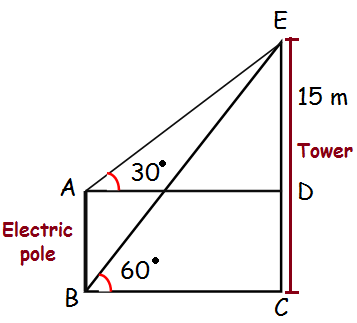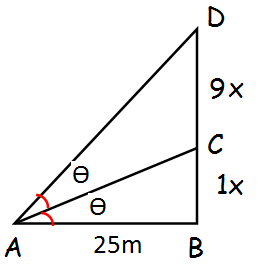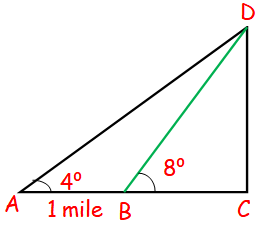TRIGONOMETRY PRACTICAL PROBLEMS USING ANGLE OF ELEVATION
Subscribe to our ▶️ YouTube channel 🔴 for the latest videos, updates, and tips.
Problem 1 :
The top of a 15 m high tower makes an angle of elevation of 60° with the bottom of an electronic pole and angle of elevation of 30° with the top of the pole. What is the height of the electric pole?
Solution :

Let DC = x, ED = 15 - x
Height of the electric pole = AB = DC
AD = BC
In triangle AED,
tan θ = Opposite side / Adjacent side
tan 30 = ED/AD
1/√3 = (15 - x)/AD
AD = (15 - x)√3 ----(1)
In triangle BCE,
tan 60 = EC/BC
√3 = 15/BC
BC = 15/√3
BC = (15/√3) ⋅ (√3/√3)
BC = 15√3/3 = 5√3----(2)
(1) = (2)
(15 - x)√3 = 5√3
15√3 - x√3 = 5√3
15√3 - 5√3 = x√3
x = 10√3/√3
x = 10
So, the height of the electric pole is 10 m.
Problem 2 :
A vertical pole fixed to the ground is divided in the ratio 1:9 by a mark on it with lower part shorter than the upper part. If the two parts subtend equal angles at a place on the ground, 25 m away from the base of the pole, what is the height of the pole?
Solution :

By using angle bisector theorem,
Let the the two parts subtend equal angles at point A such that
CAB = DAC = θ
BC/DC = AB/AD
1/9 = 25/AD
AD = 25(9)
AD2 = AB2 + BC2
2252 = 252 + (10x)2
100x2 = 2252 - 252
100x2 = (225 + 25) (225 - 25)
100x2 = (250) (200)
x2 = 500
x = 100√5 m
Problem 3 :
A traveler approaches a mountain on highway. He measures the angle of elevation to the peak at each milestone. At two consecutive milestones the angles measured are 4° and 8° . What is the height of the peak if the distance between consecutive milestones is 1 mile. (tan 4° = 0.0699, tan 8° = 0.1405)
Solution :

Let BC = x
In triangle BDC,
tan 8 = DC/BC
0.1405 = DC/x
DC = 0.1405 x ----(1)
In triangle ADC,
tan 4 = DC/AC
0.0699 = DC/(1 + x)
DC = 0.0699(1 + x) ----(2)
(1) = (2)
0.1405 x = 0.0699(1 + x)
0.1405 x = 0.0699 + 0.0699 x
(0.1405 - 0.0699)x = 0.0699
0.0706 x = 0.0699
x = 0.0699/0.0706
x = 699/706
x = 0.99
By applying the value of x in (1), we get
DC = 0.1405 (0.99)
DC = 0.14 mile
So, the height of peak is 0.14 mile.
Subscribe to our ▶️ YouTube channel 🔴 for the latest videos, updates, and tips.
Kindly mail your feedback to v4formath@gmail.com
We always appreciate your feedback.
About Us | Contact Us | Privacy Policy
©All rights reserved. onlinemath4all.com

Recent Articles
-
10 Hard SAT Math Questions (Part - 44)
Jan 12, 26 06:35 AM
10 Hard SAT Math Questions (Part - 44) -
US Common Core K-12 Curricum Algebra Solving Simple Equations
Jan 07, 26 01:53 PM
US Common Core K-12 Curricum Algebra Solving Simple Equations -
10 Hard SAT Math Questions (Part - 4)
Jan 05, 26 06:56 PM
10 Hard SAT Math Questions (Part - 4)
